After coming to Vietnam for the first time in 2014, falling in love with a Vietnamese woman and moving to Hanoi in 2016, more than anyone, Ibrahim Rakaa – an Egyptian chef – understands that food is the biggest barrier to the Islamic community here.
With strict dietary laws set up by religious beliefs and culture, all foods served to Muslims have to meet the Halal, meaning permissible or lawful, standards.
Although the Islamic community accounts for one-fourth of the world’s population, the term Halal is still unknown to most Vietnamese people.
Rakaa and his wife have poured their hearts and souls into opening a Halal Egyptian restaurant to service Hanoi’s tiny Islamic community and bring Arabic cuisine closer to the locals.
On a menu full of dishes strange to Vietnamese people, there is a familiar friend: pho.
“It’s a special dish exclusively to treat my regular guests and close friends,” said Rakaa on an early winter day.
“Pho is suitable for Muslims as none of its ingredients are prohibited.
“It only needs cooking by a Muslim chef using Halal beef.”
Sourcing permissible ingredients, however, is not as easy as it seems.
To cook an authentic pot of pho for Muslims, Rakaa and his co-workers spend days in different northern localities in search of high-quality oxen and do the butchering by themselves.
“Supermarkets have started importing frozen beef with Hala certification but we cannot cook pho with that meat,” said Rakaa.
The quintessence of Vietnamese pho lies in the ultimately clear but rich broth which can only be achieved by stewing freshly-cut bones in meat for at least eight hours.
Despite having a strong appetite, Muslims are easily persuaded by pho as the dish has flavors similar to their food’s.
“After being taught to cook pho by my wife, I realized spices used in this dish, onion, black cardamom, cinnamon or star anise, are also what made biryani – spiced rice loved by every Musim,” he explained.
Pho bears special characteristics of Vietnamese cuisine while adhering with the Islamic diet.
“That is the key to bringing Vietnamese food closer to the community,” he said.
Barrier
“A wonderful dish,” exclaimed Palestinian Ambassador to Vietnam Saadi Salama as he recalled his early days in Hanoi back in the 1980s.
Going to Vietnam for study, the Palestian student, at the time only, dared to eat banh mi with boiled eggs and pepper salt as he was afraid of violating the dietary laws.
“A Palestian friend later took me to eat a bowl of chicken pho,” he recollected.
“Every spoon of hot broth warmed me up from the inside.
“Since the first sip, I have become a dedicated fan of pho.”
The ambassador has never let any week pass by without having a bowl of pho.
Besides his favorite chicken pho restaurant on Ngu Xa Street in Hanoi’s Tay Ho District, he enjoys discovering new pho shops around the capital city.
Decades of living in Vietnam has enabled Salama to learn by heart the list of renowned pho shops, usually those specializing in a single variety.
“Medium-rare beef pho, stir-fried beef pho with a lot of onion or chicken pho with clear broth – there are so many choices for pho fans,” he said.
|
|
| Armenian Ambassador to Vietnam Vahram Kazhoyan and his spouse enjoy pho at a gala dinner in Hanoi in December 2020. Photo: Nam Tran / Tuoi Tre |
Unlike beef pho which requires a sophisticated and complicated preparation, simpler chicken pho is a dish that Ambassador Salama’s family usually has at home.
Learning tips from famous chicken pho shops, he said to make a delicious pot of pho, chickens have to be boiled at the right time to get crunchy skin.
Chickens should be cooled down before being deboned and torn into pieces.
“People from the Middle East hate poultry smell from chicken so I always open the lid and add cardamom – a familiar Arabic spice – to the broth to wash away bad smell while still preserving the original taste of the dish,” he shared his tip.
“It will be sold well,” said Ambassador Salama when talking about pho’s potential of winning over eaters in the Middle East where 30 percent of the world’s Islamic population live.
“Pho soup is easy to eat and comforting while stir-fried pho is boldly tasty.
“Pho can be eaten any time.”
Unfortunately, pho is still unpopular in the Middle East.
The market is still open, not only because of the cultural matter but also a barrier of Halal certification.
Cuisine passport
Yully Yudhantari Saputri – third secretary at the Indonesian Embassy in Hanoi – lost count of the times she answered inquiries on Halal pho restaurants in Hanoi from tourists.
“Besides the excitement to enjoy famous pho in its homeland, Indonesian travelers have to deal with worries about Halal standards,” Saputri told Tuoi Tre News.
There are just some Halal restaurants in Hanoi, those which serve pho are fewer.
Calling herself a liberal person and always wanting to try pho if she knows there are no prohibited ingredients, lard for example, Yully said it was crucial for restaurants to meet Halal standards to attract and receive Islamic tourists to Vietnam.
“Transparency is pho’s biggest advantage to win over Muslims,” she said, explaining that despite complicated cooking techniques, it was easy for diners to point out ingredients used to make a bowl of pho.
However, to seriously make further moves to Halal food markets, including Indonesia – the world’s largest Muslim country – being certified as Halal by appointed agencies is essential.
“Especially when Vietnam has an advantage of producing special instant pho which is loved by many customers,” said Saputri.
The Indonesian Embassy’s third secretary said there was just “another small step” to have Vietnamese pho receive the welcoming it deserved.
“Pho is a dish capable of introducing Vietnam as a nation,” she said.
“It is a ‘passport’ bringing the Vietnamese cuisine to the world.
“This is actually what we are trying to do with our fried rice nasi goreng yet the reality is still behind expectations.
“Vietnam is able to do so.”
Nguyen Trung Kien, head of the Middle East-Africa Department under the Ministry of Foreign Affairs, said Vietnamese cuisine could still meet standards set by religious beliefs.
“The Vietnamese tolerance and openness are well reflected through pho,” he said.
Pho featured in royal menu
Sitting on a small chair by a sidewalk in the Vietnamese capital, Swedish Ambassador to Vietnam Ann Måwe ordered a boiling hot bowl of vegetarian pho with poached eggs.
It was an early winter day in Hanoi and a chilling breeze blew from West Lake.
Skillfully using chopsticks to twirl a small bunch of pho to a spoon, Ambassador Måwe said Scandinavian people had simple breakfast with cool food such as cereal with milk, unlike Vietnamese people who prefer hot and filling dishes.
“How fortunate it is that we can have pho anytime during the day,” she said.
That lunch, she also ordered some crispy deep-fried breadsticks to dip into the savory broth.
Recalling the historic visit to Vietnam of King Carl XVI Gustaf and Queen Silvia in 2004, she told Tuoi Tre News a popular story.
“Extremely impressed by the pho served at the banquet, His Majesty the King and Her Majesty the Queen decided that they had to incorporate it in their tradition,” she said.
“So what I heard is that in the Royal Palace they have pho during the Christmas week, nowadays.”
Sweden’s Crown Princess Victoria Ingrid Alice Desiree told Prime Minister Nguyen Xuan Phuc this story during her official visit to Vietnam in May 2019.
“Pho is loved by Swedish people as a delicious, fulfilling, and heart-warming dish,” said the ambassador.
“We’ve had a lot of Vietnamese restaurants in Stockholm in the last five to 10 years or so,” she added.
“This special dish is opening the door for Vietnamese cuisine to Nordic countries.”
Like us on Facebook or follow us on Twitter to get the latest news about Vietnam!





